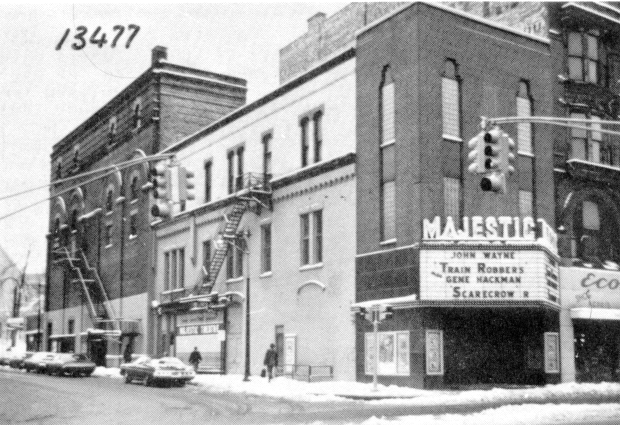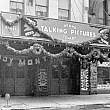Majestic
The Majestic Theater was constructed in 1903 by architect Colonel J.M. Wood. At the time, it featured the largest stage of any theater in the state, and a stage entrance so large that it was possible to drive a team of horses directly from the street onto the stage. A legitimate theater built for stage plays and presentations, it moved through the vaudeville era to a combination of vaudeville and movies. In the city directories from 1915 through at least 1920, it is called the Majestic Gardens. Walter J. Norris returned to Grand Rapids in 1933 as the city manager for the Butterfield theater chain; and was the on-site manager for the Majestic, the chain's flagship. LaVern R. Sicotte replaced Norris as manager in 1936 when the latter moved to the Regent. In 1942, Arthur H. Sanford was the Majestic manager. Goodrich and Consolidated Theaters operated it from the early 1960's until it closed on July 21, 1974. The 3-story brick building is situated on an irregular lot 25' x 90' x 108' x 115', with a total land area of 14,494 square feet. The building itself has 19,000 square feet of space, concrete floors of medium capacity, is fueled by gas, and is 75% air conditioned. Total seating capacity was 1,200, with 700 on the main floor and the remainder in two balconies. A third balcony was covered over in later renovations. The lobby ran straight along the north side of the building; patrons turned right and went into the auditorium facing south. The Majestic had 2,250 square feet of office space on the second and on the third floors. The last of the big downtown movie houses, it was slated for demolition in 1979, when it was purchased by the Grand Rapids Civic theatre, which is the second-largest community theater in the U.S. Pipe organ repairman Stan Stone of Muskegon estimates (1993) that the Majestic Theater's twin-chambered Barton Theater Organ was buiIt about 1926. In those days, canaries sang in cages against the theater walls as organist Johnny Milanowski rode up from the orchestra pit, playing in prelude to a movie. Installed at the dawn of the "talkies," instead of providing musical background and thrilling sound effects, it was used to entertain before and after shows. Eventually it fell into disuse, and lay dormant for years until it was refurbished and enjoyed a brief revival in the 1970's. An organist played on Saturday nights; but the theater closed as business and shoppers fled to the suburbs. The assessed valuation of the building was $67,500 when it was listed for sale along with the neighboring Butter Wagon restaurant for only $85,000. The Grand Rapids Civic theatre obtained the building in a land swap in 1978 and renovated the building for live theatrical productions, with the address of 30 Division N. The Civic theatre was established in 1926. After using the old Center Theater at 240 Monroe N.W. in the late 1950's and early 1960's, the Civic theatre moved to the old Our Theater at 737 Leonard N.W. and then to the former Majestic. The Civic theatre adjusted the front entrance to its present Library Street position. In the final days of the movie theater, Jack K. McCarthy, then 59 years old, who had managed the theater since the early 1950's, sold the organ to members of the Muskegon-based West Michigan Theater Organ Society. Parts of the organ were used to rebuild another now in the Frauenthal Center in downtown Muskegon. In the early 1990's, the 3-manual console was sold privately--actually traded for a model steam locomotive--to Ken Bohn of Hastings, and is used as the keyboard to control a complex modern organ in the basement of his home; Bohn and his wife, Maggie, moved to 4705 Bluegrass Drive, S.E., in Kentwood, in late 1999, and moved the great console with them. (Cf. GRP 03/11/2001 J1 & 4.) In 1993, a deal was made to combine the organ with two similar instruments in the Music House museum near Traverse City. (Cf. GRP 12/26/1993 A23. Also GRP Northwest 03/16/1995 14.) In the 1970's, former manager Jack McCarthy had a fine collection of Grand Rapids theater material. (Cf. Gordon Harrington, the Interpreter, March 20, 1975, p. 13.) (Old # 28 N. Division. Photos: left, G.R. Public Museum, in Mapes & Travis, Pictorial History of Grand Rapids, p. 145, c. 1928; right, GRPL 287, January 31, 1974, No. 13477.)
Full Details
| Title | Majestic |
|---|---|
| Address | 34 Division AVE N 49503. 8-6351 (1945) |
| Creator | Father Dennis Morrow |
| Also Known As | Majestic Gardens |



